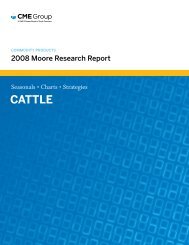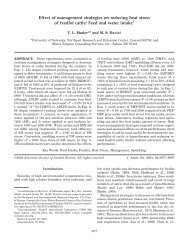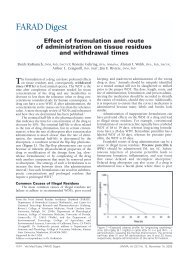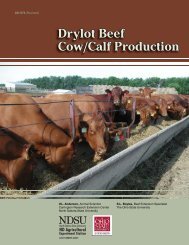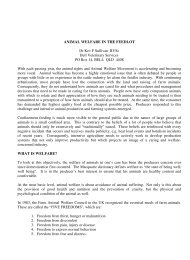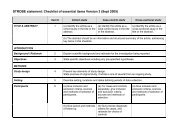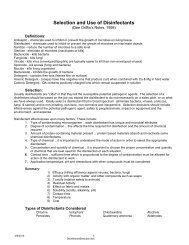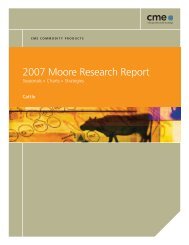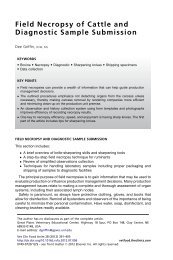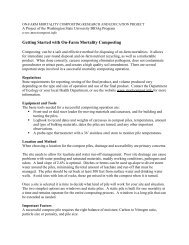CRIMES WITHOUT CONSEQUENCES - gpvec
CRIMES WITHOUT CONSEQUENCES - gpvec
CRIMES WITHOUT CONSEQUENCES - gpvec
You also want an ePaper? Increase the reach of your titles
YUMPU automatically turns print PDFs into web optimized ePapers that Google loves.
5. Enforcement of Federal Law in U.S. Plants<br />
The USDA-FSIS Rules of Practice provide that the department may take a regulatory<br />
control action because of inhumane handling or slaughter of livestock. 96 Regulatory<br />
control actions available to the agency include the issuance of NRs, reject tags,<br />
NOIEs, suspension of inspection, letters of warning and withdrawal of inspection.<br />
This section reviews FSIS use of these various actions for instances of inhumane<br />
handling and/or slaughter.<br />
5.1 Noncompliance Records<br />
FSIS inspection personnel present at slaughter establishments include at least one<br />
veterinarian, responsible for evaluating the general health of animals before slaughter<br />
(“ante-mortem”), and non-vet food inspectors, who have various inspection duties, in<br />
addition to other tasks. Inspectors are required to monitor slaughter practices, and are<br />
expected to notify a plant manager of observed deficiencies in compliance with food<br />
safety regulations by completing an NR. These records document noncompliances with<br />
humane handling and slaughter standards and inform the plant that it must take action to<br />
remedy the problem. The form includes a description of the inhumane handling/slaughter<br />
incident, completed by inspection personnel, the name of plant personnel notified of the<br />
violation, and a section for plant management to respond to the charge and offer a plan to<br />
prevent reoccurrence. 97<br />
In March 2004, a Freedom of Information Act (FOIA) request was submitted to FSIS for<br />
all NRs, citing the humane handling and slaughter inspection procedure code (04C02)<br />
issued to U.S. plants between October 1, 2002 and March 31, 2004. Thirty months<br />
later, the FSIS released a total of 424 records. The U.S. GAO obtained 553 humane<br />
slaughter NRs for the period January 2001 to March 2003. 98 In addition, The Washington<br />
Post conducted an analysis in 2001 of 527 NRs, citing humane handling and slaughter<br />
deficiencies, written from 1996 to 1997. 99<br />
The GAO report questioned the reliability of the information it received, noting that<br />
USDA officials wrote at least 44 additional NRs during the period that were not released.<br />
96 9 CFR 500.2(a)(4).<br />
97 USDA-FSIS Quarterly Enforcement Report, July 7, 2006 to August 30, 2006, p. 5. (http://www.fsis.usda.<br />
gov/regulations_&_policies/Quarterly_Enforcement_Reports/index.asp) FSIS Notice 46-07, issued July 25,<br />
2007, lists the following information to be included on NRs: 1) a description of each noncompliance in clear,<br />
concise terms, including the exact problem, time of occurrence, location, and effect on the product, if any, 2) an<br />
explanation of how establishment management was notified of the noncompliance, 3) the number of previous<br />
NRs with the same cause if there is a developing trend of noncompliance, 4) any applicable deadlines, and 5)<br />
whether a regulatory control action (tag) was applied. An earlier version of the Notice (42-07, dated July 10,<br />
2007) required a list of previous related NR and not just the number.<br />
98 U.S. GAO, Humane Methods of Slaughter Act: USDA has addressed some problems but still faces<br />
enforcement challenges, GAO-04-247, January 2004.<br />
99 Warrick T, They die piece by piece, The Washington Post, April 10, 2001.<br />
39




